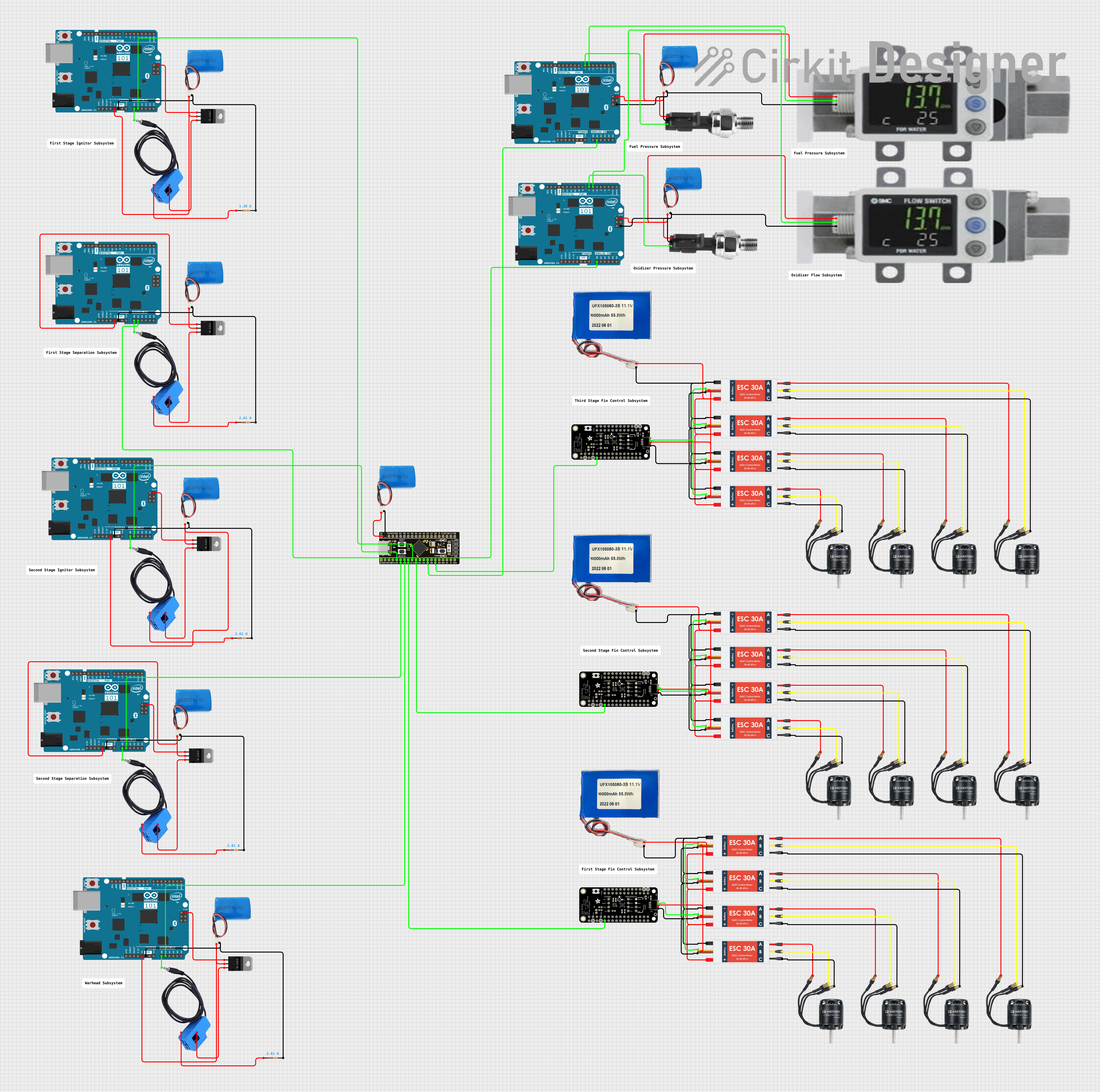
Multi-ESC BLDC Motor Control System with Adafruit 9-DoF Sensor Feedback

Circuit Documentation
Summary
The circuit in question appears to be designed for controlling Brushless DC (BLDC) motors using Electronic Speed Controllers (ESCs), with a system for monitoring and controlling the setup through various sensors and microcontrollers. The circuit includes multiple ESCs connected to BLDC motors, which are powered by Lithium-ion batteries. Additionally, there are Adafruit Precision 9-DoF boards for sensing, Arduino 101 microcontrollers for processing, and various other components such as MOSFETs, resistors, and current sensors for control and protection. The circuit lacks embedded code for the microcontrollers, which would be necessary for the operation of the system.
Component List
Power Sources
- Lithium-ion Battery 10000mah: Provides the main power source for the ESCs and motors.
- 5v battery: Supplies power to the microcontrollers and other 5V components.
Control and Processing
- Arduino 101: Microcontroller board used for processing and control logic.
- STM32F4 BlackPill: A powerful microcontroller board with an ARM Cortex-M4 processor.
Sensing and Monitoring
- Adafruit Precision 9-DoF ISM330DHCX + LIS3MDL FeatherWing: A sensor board with accelerometer, gyroscope, and magnetometer for motion tracking.
- current_sensor: Measures the current flowing through a part of the circuit.
- Industrial Pressure Sensor: Measures pressure in a system.
- Digital Flow Switch: Monitors the flow of a fluid in a system.
Power Management and Distribution
- Electronic Speed Controller (ESC): Controls the speed of a BLDC motor by varying the power supply to the motor.
- nMOS Transistor (MOSFET): Acts as a switch to control the flow of current.
- Resistor: Provides resistance in the circuit, used for current limiting or voltage division.
Actuators
- BLDC Motor: A type of electric motor that is driven by electronic commutation instead of mechanical brushes.
Miscellaneous
- Comment: Placeholder for additional notes or comments in the circuit design.
Wiring Details
Electronic Speed Controller (ESC)
- Battery VCC: Connected to the positive terminal of the Lithium-ion Battery.
- Battery GND: Connected to the negative terminal of the Lithium-ion Battery.
- Signal: Connected to the SDA pin of the Adafruit Precision 9-DoF board for control signals.
- 5v out: Provides a 5V output, connected to the 3.3V pin of the Adafruit Precision 9-DoF board.
- GND out: Ground connection, connected to the GND pin of the Adafruit Precision 9-DoF board.
- M1, M2, M3: Connected to the corresponding wires A, B, C of the BLDC Motor.
BLDC Motor
- Wire A, Wire B, Wire C: Connected to the M1, M2, M3 pins of the corresponding ESC.
Adafruit Precision 9-DoF ISM330DHCX + LIS3MDL FeatherWing
- SDA: Connected to the Signal pin of the ESCs.
- 3.3V: Connected to the 5v out pin of the ESCs.
- GND: Connected to the GND out pin of the ESCs.
Arduino 101
- 5V: Connected to the positive terminal of the 5v battery.
- GND: Connected to the negative terminal of the 5v battery.
- A0: Connected to the Out pin of the current_sensor.
- A1: Connected to the STM32F4 BlackPill board.
STM32F4 BlackPill
- 5V: Connected to the positive terminal of the 5v battery.
- GND: Connected to the negative terminal of the 5v battery.
- Various GPIOs: Connected to the Adafruit Precision 9-DoF board and Arduino 101.
Current Sensor
- Out: Connected to the A0 pin of the Arduino 101.
- In_current: Connected to the source pin of the nMOS Transistor (MOSFET).
- Out_current: Connected to the pin1 of the Resistor.
nMOS Transistor (MOSFET)
- Drain: Connected to the positive terminal of the 5v battery.
- Gate: Connected to the 5V pin of the Arduino 101.
- Source: Connected to the In_current pin of the current_sensor.
Resistor
- Pin1: Connected to the Out_current pin of the current_sensor.
- Pin2: Connected to the negative terminal of the 5v battery.
Code Documentation
No code has been provided for the microcontrollers in the circuit. For the system to function, embedded code would need to be written and uploaded to the Arduino 101 and STM32F4 BlackPill boards. The code would handle tasks such as motor control through the ESCs, reading sensor data, and implementing control algorithms based on the sensor inputs.